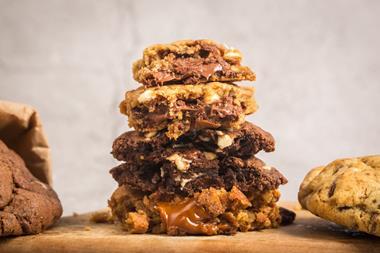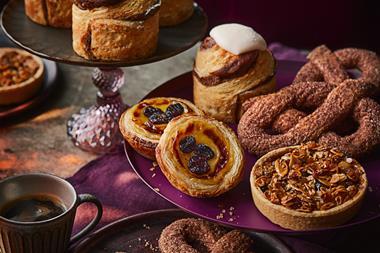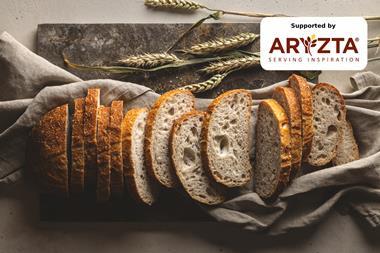Brits are demanding more from their sarnies, prompting a drive towards high-quality fillings and bread that is increasing spend in the category.
You can download a pdf of this report here
The value of the sandwich market has grown from £7.5bn in 2015 to about £8bn last year, according to the British Sandwich Association (BSA), despite little growth in the number of sandwiches sold.
Value growth is being driven by consumers choosing better-quality products over lower prices, says BSA spokesman Gethin Evans. “Instead of just going for standard cheese or ham, we’re seeing them trade up to slightly more expensive ingredients. Chicken is very popular, and it’s very versatile.”
Retailers and suppliers are also benefiting from consumers buying sandwiches earlier and later in the day than in the past, as suggested in research carried out for the BSA by Kantar Worldpanel. This gives businesses an opportunity to increase spend on sandwiches by offering tailored deals, such as a coffee and a sandwich at breakfast.
“While weekday lunch will remain the heartland of the sandwich, consumers are increasingly eating out of home throughout the whole 24-hour period,” says Greencore Food to Go category head Iain Mayhew. “For shift workers, lunchtime may be in the middle of the night! Ensuring round-the-clock availability and broadening the range of options on offer will be key in winning in day-part ranging.”
James Simpson, managing director of food-to-go supplier FSC (Food Service Centre) adds: “More meal occasions are being taken on the go and people are looking for new and more creative products. Drive value by having more premium products out there that people can choose from.”
This expansion in market opportunities, and shoppers’ willingness to trade up to high-priced products is good news for sandwich manufacturers grappling with cost increases, driven in no small part by the weakness of sterling following the Brexit referendum.
Some manufacturers are protecting margins by switching to cheaper ingredients, suggests John Want, marketing director at food-to-go supplier Adelie Foods, emphasising that this is not a route his business is taking. “One thing we’re not doing is specification erosion. We’re not cost engineering because, for the past year or two, the consumer has been paying more money for the right product and the right experience. Some customers of ours who have cost-engineered have maybe not performed as well as others that have stood firm, adjusted their retail prices and looked at the mix of products on offer to create a good balance of value.”
Brexit has also brought concerns about the future of migrant workers, who make up a large part of the food-to-go industry’s 300,000 employees. At the start of this year, BSA director Jim Winship sent an open letter to David Davis MP, minister in charge of Brexit, arguing against a points system of immigration that would discriminate against the thousands of low-skilled workers the foodservice industry needs to be able to maintain growth.
“We commissioned research with the University of Coventry last year and they made projections about the number of additional staff that would be required if the industry continues to grow as it has. We’re looking at several hundred thousand additional members of staff required across the industry, which basically aren’t available within the UK,” says the BSA’s Evans.
With Brexit putting pressure on suppliers and their customers, most sandwich manufacturers are banking on innovation to grow the market in the coming year.
“We’re constantly innovating with fillings – I think that’s happening right across the food industry, particularly with authenticity,” says Simpson.
“We’ve always tried to develop alternative flavours and use authentic ingredients, and the availability of those ingredients is increasing, so we’re able to get better at that. If we say we’re doing a Vietnamese Bánh mì [sandwich], then we’re using as many of the authentic ingredients as we can to deliver the most authentic taste.”
The trend for authenticity is also important to bakers such as Délifrance, which alongside French breads such as baguettes, also produces Italian breads and opened a stonebaked plant in 2015 to create traditional breads with a more open texture.
As well as authenticity and new flavours, dietary requirements are also playing a big role in innovation. Evans points out that the quality of gluten-free bread has come on in “leaps and bounds” in the past few years. “When you look at the noughties, nobody touched gluten-free bread because it was unpalatable to many consumers. You’d be hard pushed now to tell the difference.”
And despite the long-term decline in sales of standard wrapped loaves, Brits have not lost their love for bread, according to Evans. “Customers are not turning away from bread – they’re turning away from plant-manufactured sliced loaves,” he adds. “The big trend for the next year will not be about the filling, it will be about the bread. What some retail businesses are doing in terms of bread – as well as artisan bakers and cafés – has really educated the public on the different types of bread out there.”
But it is not always easy for sandwich manufacturers to source speciality breads, and Adelie Foods’ Want says this is a good opportunity for bakers to work with food-to-go businesses.
Meanwhile, FSC is urging bakers to experiment and take on niche breads. Demand may be small now but if it grows, it will stand both the baker and the sandwich manufacturer in good stead in the future.
Sandwich innovation
Zhug, Egg & Avo Flat Bread, Pret A Manger
Launched: January 2017
Despite the popularity of Middle Eastern foods such as humous and falafel, hot sauce zhug is unfamiliar to most Brits and is virtually unseen in the food-to-go market. However, high street coffee and sandwich supplier Pret A Manger is hoping to bring the potentially popular ingredient into the mainstream with this vegetarian Zhug, Egg & Avo Flat Bread.
Delicious Coronation Chicken, Boots
Launched: January 2017
Coronation chicken is not commonly associated with being a low-calorie or healthy option. Boots’ version – chicken breast in a coronation dressing with cucumber and spinach on malted bread – is labelled as containing one of “your five a day” and has a calorie count of 397 calories, putting it in an “everyday” range for most people.
Roots range, Urban Eats from Adelie Foods
Launched: October 2016
Urban Eat has introduced a range of veggie and vegan sandwiches to appeal to vegetarians and flexitarians. The Roots line-up, which is approved by the Vegetarian Society, comprises nine sandwiches and wraps, including Feta The Better (feta, olive and peppers), Rocket Eggs (egg mayo and spicy tomato chutney) and Mozza Ella Ella (mozzarella, pesto, tomato and rocket).
Rainbow wraps, The Co-operative
Launched: January 2017
Using vegetable extracts, The Co-operative has developed a range of three different coloured wraps, each taking on a different flavour. Its Beetroot & Feta, Chicken & Spinach, and Chicken Korma wraps, which retail at £3 each, are designed to be attractive options for the health-conscious consumer. They each contain 400 calories or less.
Automation – a step too far?
Full automation is often the dream for manufacturers but not so in the sandwich industry.
Most of the tasks that go into making a sandwich are currently carried out by hand with, perhaps at most, a machine buttering the bread and cutting the finished sandwich.
Automation is one of the main challenges facing the industry in the next decade, according to a report released by the British Sandwich Association (BSA) in October.
While there are gains to be made – particularly as the average sandwich production line employs 20 workers – the technology is not there just yet.
Many of the machines needed to fully automate the process simply do not exist yet, says BSA spokesman Gethin Evans, largely because the complexity of different sandwich ingredients makes designing machinery to suit the job a difficult task.
“How does a machine handle and slice something such as an avocado, which by its very nature or by its orientation changes shape?” he says.
“If you hold an avocado in one direction, a gripping hand would be able to pick it up, if you turn it through 90 degrees it’s a very different beast for that automated machine to be able to pick up – not to mention the stone is in a very different place, for example. You can apply the same logic to a great number of products.”
While handling a diverse range of ingredients is one challenge, the varied nature of orders that sandwich manufacturers fulfil adds another layer of complexity.
After producing one type of sandwich, it would be a difficult task getting machines ready to start on the next product. The entire line would need to be cleaned and retooled – particularly when dealing with meat and vegan fillings.
“Whereas, from a manual perspective, all you need to do is wash your hands and clean the surface and you can move on and create the next sandwich,” Evans says.
However, the BSA does believe it is possible to move to automated lines eventually. “Automation clearly has a number of benefits, not to mention cost [savings].There’s a great deal of research being done, from the tooling manufacturers’ perspective, to be able to create such a range of products that will be able to deal with that – but we’re not in that place just yet,” Evans adds.


























No comments yet